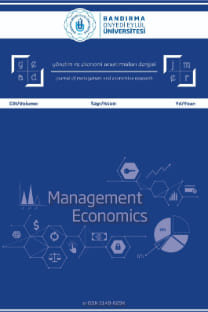Cepten yapılan eğitim harcamalarının hane halkı gelirine mali yükü: Türkiye için istatistiksel bir analiz1
Financial burden of out of pocket education expenditures on household s budget: Statistical analysis for Turkey
___
- Bakış, O., Levent, H., İnsel, A. ve Polat, S. (2009) Türkiye‟de Eğitime Erişimin Belirleyicileri,Türkiye‟de Eğitimde Eşitliğin Geliştirilmesi İçin Verilere Dayalı Savunu Projesi Araştırma Raporu, http://www.erg.sabanciuniv.edu, (01.06.2012).
- Banthin, J. S. ve Bernard, D. M. (2006) Changes in Financial Burdens for Health Care , The Journal of the American Medical Association, 296(22): 2712 -2719.
- Banthin, J. S., Cunningham, P. ve Bernard, D. M. (2008) Financial Burden of Health Care, 2001 - 2004, Health Affairs , 27: 188 -195.
- Berki, S. E. (1986) A L ook at Catastrophic Medical Expenses and the Poor, Health Affairs , 5(4): 138- 145.
- Dünya Bankası (2005b) Türkiye-Eğitim Sektörü Çalışması: Okul Öncesi Eğitimden Orta Öğretime Etkili, Adil ve Verimli Bir Eğitim Sisteminin Sürdürülebilir Yolları, Dünya Bankası Raporu, 32450.
- Ekinci, C. E. (2009) Türkiye‟de Yüksek Öğretimde Öğrenci Harcama ve Maliyetleri, Eğitim ve Bilim Dergisi, 34(154) : 119- 133.
- Gurun, A. ve Millimet, D. L. (2008) Does Private Tutoring Payoff?, IZA Discussion Paper , 3637: 1 - 24.
- Kavak, Y. (2010) 2050‟ye Doğru Nüfusbilim ve Yönetim: Eğitim Sistemine Bakış , Türk Sanayicileri ve İşadamları Derneği Birleşmiş Milletler Nüfus Fonu Raporu, 11.
- Kibritçioğlu, A. (1998) İktisadi Büyümenin Belirleyicileri ve Yeni Büyüme Modellerinde Beşeri Sermayenin Yeri, Ankara Üniversitesi Siyasal Bilgiler Fakültesi Dergisi, 53(1 - 4) : 207 - 230.
- Kurt, A. İ. ve Aksoy, H. H. (2009) The Cost of Education: A Study on the Cost of Education in the Faculty of Educational Sciences at Ankara University, Ankara University Journal of Faculty of Educational Sciences, 42( 2) : 1 - 26.
- Maastricht Bildirgesi (2004) Mesleki Eğitim ve Öğretimde Geliştirilen Avrupa İşbirliğinin Gelecekteki Öncelikleri Konusunda Maastricht Bildirgesi , http://www.megep.meb.gov.tr/ megep/genel/ab/MaastrichtBildirgesi.pdf ( 01.06.2012).
- Mankiw, G., Romer , D. ve Weil, D. (1992) A Contribution to the Empirics of Economic Growth, Quarterly Journal of Economics , 152: 407 -437.
- Mete, C. (2005) Education Finance and Equity in Turkey, The World Bank Report: Turkey Education Sector Study içinde, Washington: World Bank, 99- 106.
- Romer, P. M. (1986) Increasing Returns and Long -Run Growth, Journal of Political Economy, 94 (5): 1003- 1037.
- Tansel, A. ve Bircan, F. (2005) Effect of Private Tutoring on University Entrance Examination Performance in Turkey, ERC Worki ng Papers in Economics, 04 : 1 - 23.
- Tansel, A. ve Bircan, F. (2006) Demand for Education in Turkey: A Tobit Analysis of Private Tutoring Expenditures, Economics of Education Review, 25 : 303 -313.
- Türkiye İstatistik Kurumu (2002) Eğitim Harcamaları Araştırması, Ankara: TÜİK Baskısı.
- Türkiye İstatistik Kurumu (2003) Hane Halkı Bütçe Anketi Mikro Veri Seti CD‟si, Anakara: TÜİK
- Türkiye İstatistik Kurumu (2009) Hane Halkı Bütçe Anketi Mikro Veri Seti CD‟si, Anakara: TÜİK.
- Türkiye İstatistik Kurumu (2012 ) Yaşam Memnuniyet Anketleri , http://www.tuik.gov.tr/Veri Tabanlari.do#, ( 01.06.2012).
- Türkiye İstatistik Kurumu (2012) 1923- 2010 İstatistik Göstergeler , http://www.tuik.gov.tr/ Kitap. do?metod=KitapDetay&KT_ID=0&KITAP_ID=158 , ( 20.06.2012).
- United Nations Educational, Scientific and Cultural Organization (2009) EFA Global Monitoring Report 2009, UK: Oxford University Press . World Bank (2005a)
- How Much Does Turkey Spend on Education? Development of National Education Accounts to Measure and Evaluate Education Expenditures, World Bank Report, 41058 .
- Wyszewianski L . (1986) Financially Catastrophic and High- Cost Cases: Definitions, Distinctions, and Their Implications for Policy Formulation , Inquiry, 23(4) : 382 -94.
- Xu K., Evans, D. B., Kawabata, K., Zeramdini, R., Klavus, J. ve Murray, C. J. (2003) Household Catastrophic Health Expenditure: A Multi- Country Analysis, The Lancet, 362: 111 - 117.
- ISSN: 2148-029X
- Yayın Aralığı: 4
- Başlangıç: 2013
- Yayıncı: Bandırma Onyedi Eylül Üniversitesi İ.İ.B.F.
A field research about oppression incurred of woman entrepreneurs in patriarchal societies1
Serkan BAYRAKTAROĞLU, Metin ULUKÖY
Filiz ERATAŞ, Coşkun ÇILBANT, M. Hakan YALÇINKAYA, Demet HARTOĞLU
Kobi'lerin ticari fuar teşviklerinden ve dış ticaret fırsatlarından yararlanma düzeyi
E-Gümrük uygulamasının Türkiye ile Avrupa birliği arasındaki ticarete etkisi 1
Rasyonel perspektif ışığında karar verme eylemi: Nitel bir analiz
